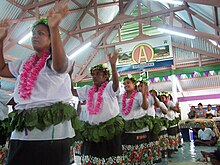This article needs additional citations for verification. (March 2014) |

Dance in Kiribati includes various styles unique to the island nation. The uniqueness of Kiribati dance when compared with other forms of Pacific Islands dance is its emphasis on the outstretched arms of the dancer and the sudden birdlike movement of the head. The Frigate bird (Fregata minor) on the Kiribati flag refers to this bird-like style of Kiribati dancing. Most dances are in the standing or sitting position with movement limited and staggered.
In 1963 Gerd Koch filmed on Tabiteuea traditional dances and songs of the ruoia series: the kawawa, the introductory song and dance; the kamei with a dance leader, the wan tarawa and the kabuakaka; and a bino song and dance complete with accompanying arm movements. Koch also filmed the song and dance of the kamei style from the ruoia dance series on Onotoa and the standing dance of the batere style that was accompanied by a choir of men and women and by drum beats. On Nonouti Koch filmed the stick dance of the tirere style.[1][2]
- ^ "IWF Wissen und Medien". Film Archives Online. Retrieved 5 February 2014.
- ^ "70 Silent Films by Gerd Koch from the Gilbert Islands". Göttingen University.